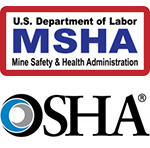Comparing and contrasting MSHA with OSHA
Nearly a full year passed from the moment President Donald Trump was inaugurated in January 2017 to the time David Zatezalo was confirmed as the assistant secretary of the Mine Safety & Health Administration (MSHA).
Chalk that delay up to business as usual in Washington, but at least MSHA currently has a guiding force at the top of the agency who spent a lifetime working in the mining industry.
The Occupational Safety & Health Administration (OSHA), on the other hand, has not had an administrator in place since David Michaels resigned from his post in 2017. The absence of an OSHA administrator has led to the continuation of Obama-era approaches at the agency, says one former OSHA area director.
“Enforcement has not slowed down at all,” says Rob Medlock, former OSHA area director for the agency’s Cleveland area office. “In fact, it has increased.”
Medlock shared insights on OSHA during a panel discussion in Columbus, Ohio, hosted by Conn Maciel Carey, a law firm focused on labor and employment, workplace safety, and litigation.
What’s driving the approach
The Department of Labor, at least, finally has a new chief in place following the confirmation of Eugene Scalia as labor secretary. Scalia’s appointment follows the resignation this summer of former labor secretary Alexander Acosta.
The confirmation of Scalia should, in theory, expedite the appointment of the next OSHA administrator. Medlock expects to see an appointment made within the next year and a half, and he anticipates the next administrator to adopt a strategy that exhibits compliance assistance.
Until then, however, expect the rate of enforcement at OSHA to continue at the pace established under the Obama administration.
“Significant cases are actually up,” says Eric J. Conn, chair of the OSHA Workplace Safety Practice Group at Conn Maciel Carey. “A ‘significant’ case used to be $100,000 under Obama. Now under Trump it is $180,000. But if you compare $100,000 cases to $100,000 cases under the two administrations, the number of $100,000 cases is up.”
Likewise, the number of $1 million-plus cases at OSHA is at a record level under the Trump administration, Conn adds.
With a Republican-led administration, the expectation should be that the number of significant cases would be down. That hasn’t been Conn’s experience, though.
“My experience representing companies is that enforcement is up,” Conn says. “If anything, there’s an enforcement creep.”
Press release practices
Another ongoing OSHA practice – one that stretches back to at least the George W. Bush administration – relates to the agency’s approach and use of enforcement press releases.
According to Conn, OSHA published about 150 of these press releases a year under the Bush administration. The tone and language of these press releases were rather neutral, he adds.
“They were reserved for the most significant enforcement actions,” he says. “They were fairly black-and-white statements.”
When the Obama administration took over, the threshold triggering an enforcement press release was lowered from $75,000 to $40,000. Not surprisingly, lowering the threshold led to an increase in the number of enforcement press releases published – roughly three times the number issued under the Bush administration, Conn says.
“The other huge change we saw was press releases were dramatic,” he says. “They put in a bunch of salacious language. One hundred percent of those press releases included nasty, insulting language.”
Fast forward to the Trump administration, and Conn describes OSHA taking a hybrid approach with enforcement press releases.
“OSHA issues press releases at about the same rate,” he says, comparing the Trump administration to the Bush administration. “It’s about 140 press releases each month, but the language is about the same as the Obama administration.”
According to Conn, the reason the tone and language are relatively the same now compared with the last administration is because OSHA lacks new senior political leadership.
“No one has been there to steer it in another direction,” he says.











